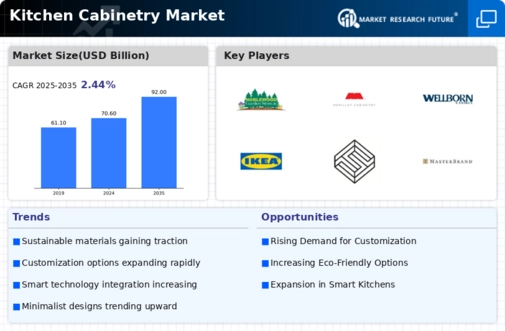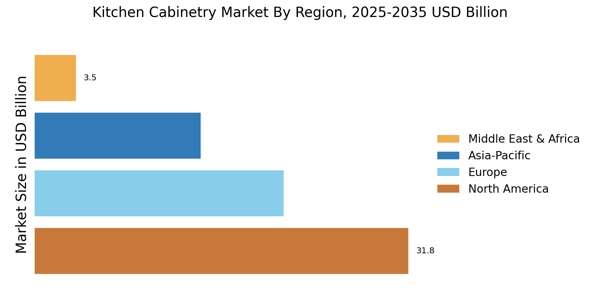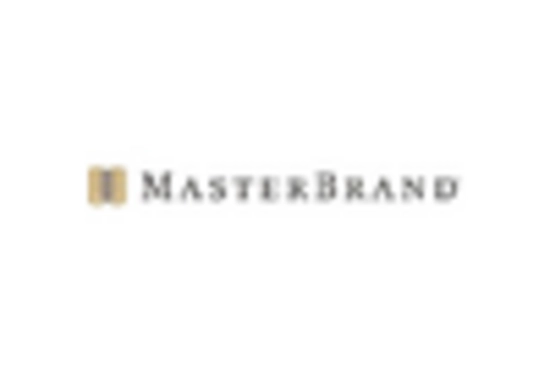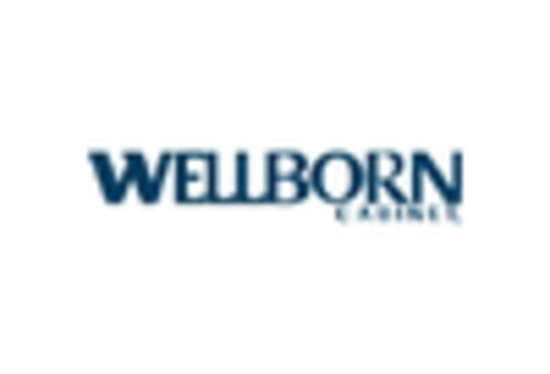Growth in Real Estate Development
The Kitchen Cabinetry Market is poised for growth, largely influenced by the expansion of real estate development. As new residential projects emerge, the demand for kitchen cabinetry is expected to rise correspondingly. Recent statistics indicate that residential construction has increased by over 7% in the past year, reflecting a robust housing market. Developers are increasingly focusing on high-quality finishes, including cabinetry, to attract potential buyers. This trend is particularly evident in urban areas where space optimization and modern aesthetics are crucial. The integration of stylish and functional cabinetry in new homes not only enhances property value but also appeals to contemporary consumer tastes. Thus, the Kitchen Cabinetry Market stands to benefit significantly from ongoing real estate developments.
Rising Home Renovation Activities
The Kitchen Cabinetry Market is experiencing a surge in demand due to increasing home renovation activities. Homeowners are investing in kitchen upgrades to enhance aesthetics and functionality. According to recent data, the home improvement market has seen a growth rate of approximately 5% annually, with kitchen renovations being a significant contributor. This trend is driven by a desire for modern designs and improved storage solutions. As more individuals prioritize their living spaces, the need for high-quality cabinetry becomes paramount. Consequently, manufacturers are responding by offering innovative designs and materials that cater to diverse consumer preferences. This dynamic environment suggests that the Kitchen Cabinetry Market will continue to thrive as renovation activities remain a priority for homeowners.
Sustainability Trends in Material Sourcing
The Kitchen Cabinetry Market is increasingly influenced by sustainability trends, particularly in material sourcing. Consumers are becoming more environmentally conscious, prompting manufacturers to adopt sustainable practices in their production processes. Recent surveys indicate that over 70% of consumers prefer cabinetry made from eco-friendly materials, such as reclaimed wood or low-VOC finishes. This shift towards sustainability is not only a response to consumer demand but also aligns with broader environmental initiatives. Manufacturers are investing in sustainable sourcing and production methods to meet these expectations, which may enhance their market position. As the trend towards sustainability continues to grow, the Kitchen Cabinetry Market is likely to evolve, with an emphasis on environmentally responsible products.
Technological Advancements in Manufacturing
The Kitchen Cabinetry Market is benefiting from technological advancements in manufacturing processes. Innovations such as computer-aided design (CAD) and automated production techniques are enhancing efficiency and precision in cabinetry production. These advancements allow manufacturers to produce high-quality products at a lower cost, thereby increasing competitiveness in the market. Recent data suggests that the adoption of advanced manufacturing technologies has led to a 15% reduction in production time, enabling quicker turnaround for custom orders. Additionally, these technologies facilitate the creation of intricate designs and personalized cabinetry solutions, catering to diverse consumer needs. As manufacturers continue to embrace these innovations, the Kitchen Cabinetry Market is likely to experience sustained growth and improved product offerings.
Increased Consumer Awareness of Design Trends
The Kitchen Cabinetry Market is witnessing a shift in consumer behavior, with heightened awareness of design trends influencing purchasing decisions. Homeowners are increasingly seeking cabinetry that reflects current styles, such as minimalist and open-concept designs. Market analysis reveals that approximately 60% of consumers prioritize aesthetics when selecting kitchen cabinetry. This trend is further fueled by social media platforms showcasing innovative kitchen designs, inspiring consumers to invest in cabinetry that aligns with their personal style. As a result, manufacturers are adapting their offerings to meet these evolving preferences, introducing a variety of finishes, colors, and configurations. This responsiveness to consumer demand indicates a vibrant future for the Kitchen Cabinetry Market, as it aligns with contemporary design sensibilities.


















Leave a Comment